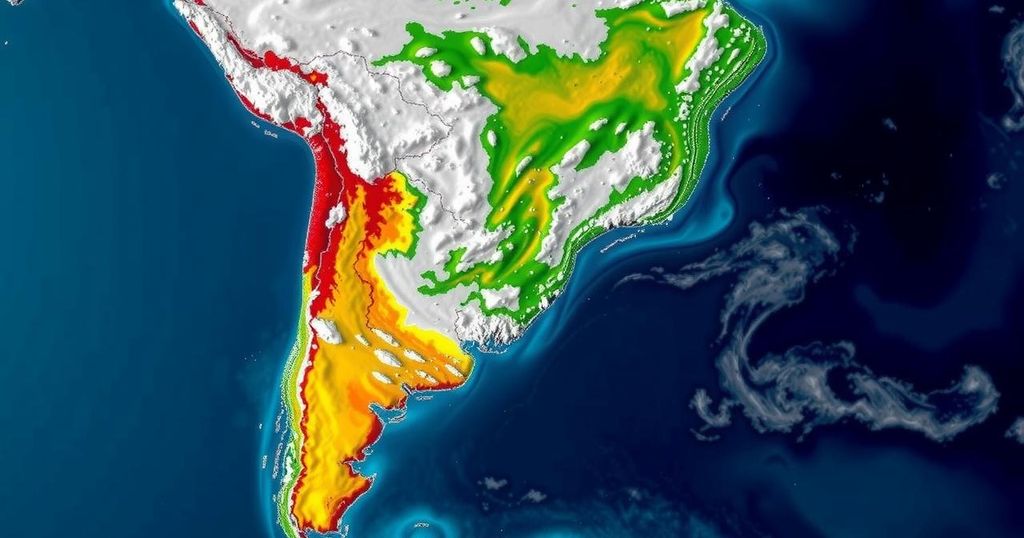Argentina and southern Brazil are transitioning from a recent period of heavy rainfall to drier conditions after heavy storms brought relief to drought-affected areas. Argentina experienced significant rainfall in certain regions, notably Cordoba, while southern Brazil benefitted from substantial moisture, aiding planting efforts. However, rising temperatures and a potential long dry stretch could present challenges before the anticipated return of rains in early November, alongside concerns related to a developing La Niña phenomenon.
Argentina is currently experiencing a transition from a period of heavy rainfall to a drier phase following recent storms. Earlier in the growing season, significant drought conditions prevailed across the country, particularly in the western regions where certain areas had remained rainless for months. However, over the past two weeks, a storm front that originated in central Brazil brought substantial precipitation, especially to the drought-stricken western parts of Argentina, including the agricultural state of Cordoba. Here, rainfall exceeded 75 millimeters (approximately 3 inches), with some locations recording more than 150 mm (around 6 inches). In contrast to Argentina, southern Brazil did not suffer from the same drought conditions and also benefited from this rainfall, with accumulations ranging from 50-100 mm (2-4 inches) in states from Rio Grande do Sul to Parana. This steady supply of moisture has allowed producers to maintain satisfactory planting rates for corn and soybeans, contributing to favorable early growth conditions. As of October 24, the weather has shifted towards a drier period with minimal rainfall expected through November 1, allowing farmers to resume planting or complete winter crop harvesting without immediate rain concerns. Despite the short-term benefits of dry weather, drought conditions persist in certain areas, particularly where high temperatures—predicted to reach the 30s Celsius (upper 80s to upper 90s Fahrenheit)—may impose stress on young plants due to reduced soil moisture availability. Looking ahead, forecasts indicate a return of rain to the Andes Mountains on November 1, potentially spreading moisture to both Argentina and southern Brazil as storm systems reemerge. However, uncertainties remain; should the forecast prove inaccurate and the dryness persists, it could raise significant concerns, especially for Argentina during its recovery from drought. Additionally, the emergence of colder surface waters in the Pacific Ocean suggests a weak La Niña phenomenon, which historically correlates with drier summer conditions in the region, raising further issues for crop viability throughout December to February.
The current weather patterns in Argentina and southern Brazil are marking a notable climatic shift. In Argentina, a serious drought hampered the initial phases of the 2024-25 growing season, particularly affecting western regions that had not experienced rain for months. This situation was alleviated somewhat by a recent storm system, which brought substantial precipitation to critical agricultural regions. Simultaneously, southern Brazil, which had better moisture conditions, has also benefited from the recent rainfall, allowing farmers to continue with their planting operations. The oncoming drier conditions may provide a necessary window for agricultural tasks such as planting and harvesting, which are essential for successful crop growth in the region. Concerns continue regarding the potential for returning dry weather through November, particularly in light of a developing La Niña, which could significantly impact rainfall patterns in the coming months. The farmers’ reliance on accurate predictions and timely weather changes is essential for maintaining crop health and productivity, given the precarious nature of agricultural weather systems.
In summary, Argentina and southern Brazil are navigating a complex climate period characterized by an initial recovery from drought conditions followed by an emerging dry stretch. The recent storm systems provided much-needed rainfall, particularly in drought-hit areas, while southern Brazil experienced overall beneficial weather for planting crops. However, the potential for rising temperatures and prolonged dryness poses a risk to crops. A careful monitoring of weather predictions and the anticipated return of rainfall in early November will be crucial for sustaining agricultural productivity. The developing La Niña phenomenon also underscores the importance of vigilance in agricultural planning as its impact could further complicate weather patterns during the summer months.
Original Source: www.dtnpf.com






